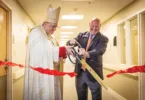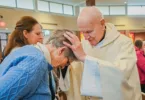by Marc and Julie Anderson
Special to The Leaven
EMERALD — Not much exists anymore of the town known as Emerald.
In its heyday, however, the rural community in Anderson County had a post office, a school, a trading post and several other shops. The buildings were all located on the slope of a hill with a church above and farm fields below.
But what was once a thriving community is gone now . . . except for one building — that of St. Patrick Catholic Church.
Known widely as the “jewel of the archdiocese” and “the cathedral of the plains,” the tiny rural parish celebrated its sesquicentennial on Oct. 3.
Parishioners, former pastors and well-wishers from neighboring communities gathered to celebrate the parish’s 150th anniversary with a Mass of thanksgiving celebrated by Archbishop Joseph F. Naumann. Concelebrants included pastor Father Marianand Mendem and former pastors Fathers Ken Kelly and Mike Hawken. A dinner followed in the church basement for all in attendance, including the 48 families who still call the parish their spiritual home.
Among those enjoying the festivities was Ed Wilper, who at age 93 is the oldest active parishioner.
The name Wilper does not automatically bring to mind all things Irish. Wilper’s heritage is of both Irish and German ancestry, a blend common to many St. Patrick parishioners.
A lifelong member of the parish, Wilper never left the area and still recalls the parish’s early days, days when parishioners did a lot of the work by hand — such as digging graves in the parish cemetery.
Wilper and his wife Agnes, who have been married for 61 years, have been involved with the parish in a myriad of ways, including serving on the parish council and the cemetery committee, singing in the choir and holding office in the Altar Society.
Ed still recalls the fire back in September 1939 and the rebuilding of the church when he was just 23 years old. He also remembers how the men of the parish used to cut wood to heat the building. The couple’s daughter, Ina, reminisced on how the building used to be quite warm in the summertime until the installation of air conditioning, made possible by another generation of parishioners.
“The younger generation has worked hard to make St. Patrick’s a thriving Catholic community,” said Agnes. “Without them, we would not have an elevator, air conditioning, a wheelchairaccessible ramp, a new floor and carpet. . . . The choir has worked hard for some time to every make Mass a celebration as has the Altar Society and the parish council to raise funds for the roof renovations. This is truly a warm and loving community, built upon the faith and love of many families.”
Expanding upon the theme of the faith and commitment of strong families, Archbishop Naumann discussed the history of the parish in his homily, offering his hopes and prayers that the parish will continue to nurture the Catholic faith for another 150 years.
“In our prayer today,” said the archbishop, “we give thanks for this parish family of St. Patrick’s, for the way in which God has blessed this community for 150 years. We remember gratefully the priests and the Sisters who have served and ministered to this community with such dedication and love. We give special thanks for the families of faith that gave life to the parish 150 years ago and those who have sustained and built upon the work of those founders. We pray that this precious emerald jewel of the archdiocese will remain a strong and vibrant parish for the next 150 years.”
Elsewhere in his homily, the archbishop discussed the permanence of marriage as a sacrament and how strong marriages are vital for a strong society.
“The strength of marriage,” the archbishop said, “is not just important to the couple — not even just to their children or their extended family.
“It is important for society, culture and the church. Society needs strong families that give life to and form the next generation.”
“God depends on the parents — not only to be co-creators with him of new human life, but to educate and form their children in the faith,” Archbishop Naumann added. “Pope John Paul spoke frequently about the family’s role in evangelization, in that the family is essential in passing the faith to the next generation.
“It is in the family that we have the opportunity to develop the virtues of generosity, fidelity, integrity, sacrificiality, etc., that make us good citizens, as well as responsible and productive members of the community.”
In conclusion, the archbishop said: “We also pray that the Lord will continue to bless the parishioners of St. Patrick’s. We pray particularly for God’s blessing on the married couples and parents of this community. May the Lord, who has called you to love your spouse, give you the grace to continue to be true to your commitments of love that are so important — not only for you, but for our society, our nation, our church and this parish of St. Patrick.”
Important dates in the history of St. Patrick
- In the 1850s, Irish immigrants from the counties of Cavan, Carlow, Termanagh, Wicklow and Queen’s settled in Anderson County and founded the town of Emerald. Named after the Emerald Isle itself, the farming community thrived and families bearing surnames like Collins, Fitzgerald, Glennon, McEvoy and Doolin formed bonds of faith and love. Given their Catholic faith and love of their motherland, it was natural for the immigrants to name their parish in honor of St. Patrick.
- In 1859, the first church — made of logs from Garnett, located 20 miles away — was built, followed nine years later by a stone church, built with rocks quarried from adjacent hills. The community and parish continued to grow. In 1895, Bishop Louis Fink laid the cornerstone for a Romanesque church to serve some 90 families now living in the area.
- Dedicated in 1899, the church featured turrets at either front corner of the building. In the center of the turrets stood a large dome surmounted by a lantern five feet high, a design that was modeled after the dome of the Kansas Capitol in Topeka. A large bell hung on the inside half of the dome which was supported by two iron columns, measuring 26 feet high. All the windows were stained glass depicting religious scenes; the main altar was hand-carved and overlaid with gold.
- The “cathedral of the plains” stood until Sept. 29, 1939, when Father J.B. Karnowski awoke sometime around 2:45 a.m. to what he later described as “the most severe crash I ever heard” as lightning struck the center dome. The ensuing fire gutted the building, leaving only the walls and the center dome. Everything else was destroyed, except one important thing: the faith of the parishioners, who immediately began rebuilding efforts to restore the church to as much of its former glory as possible.
- A year later, the rebuilt “jewel of the archdiocese” was dedicated once again, this time featuring a rather unique item: a statue of the Sacred Heart of Jesus donated by singer and actor Bing Crosby.






